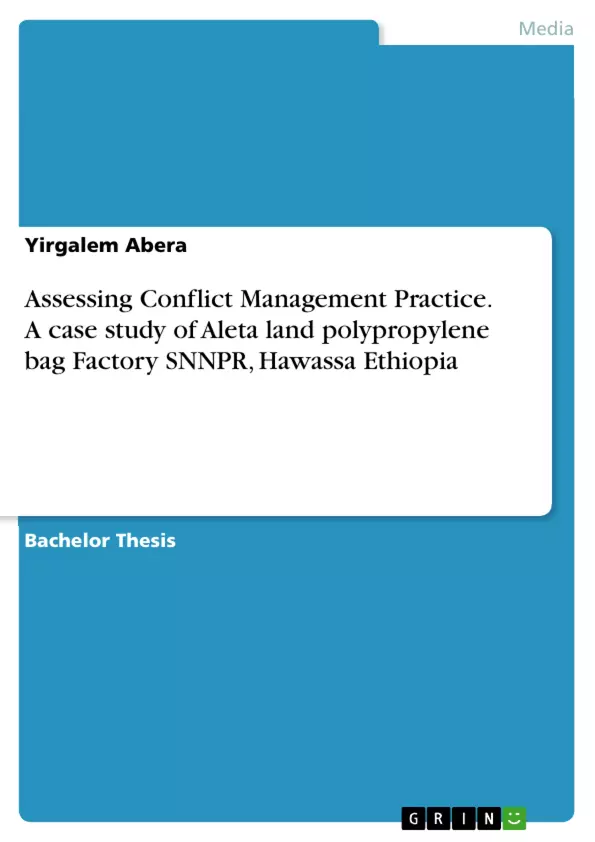In order to be highly productive and being successful in any operation is somewhat a difficult task, unless conflict is managed carefully in the organization. Therefore, the main reason of conducting this research is to find out the sources of conflict, to identify conflict resolution techniques and to know the positive and negative outcomes of conflict in the organization.
Among the factors that accounted for the existence of conflict in the organization, perpetual difference, value difference, modern technology and personality clashes were the most important. The effort of management to understand the existing conflict in the organization is low which implies the weakness of management of the organization in handling conflict. In general, undertaking conflict and assessing conflict management practice is important task for the reduction of problems which exist in the organization.
Inhaltsverzeichnis (Table of Contents)
- CHAPTER ONE INTRODUCTION
- 1.1 Background of the Study.
- 1.2. Statement of the Problem
- 1.3 Research questions......
- 1.4 Objective of the study
- 1.4.1. General objective...
- 1.4.2. Specific objectives...
- 1.5. Significance of the Study
- 1.6. Scope and Limitation of the Study.
- 1.7. Research Methodology..
- 1.7.1. Research design and strategy.
- 1.7.2. Source and type of Data
- 1.7.3. Sampling Design and technique..
- 1.7.4. Method of Data collection..
- 1.7.5. Data analysis
- 1.8. Organization of the Study
- CHAPTER TWO REVIEW LITERATURE
- 2.1 Definition of Conflict.....
- 2.2. Transitions in Conflict Thought.
- 2.2.1. The Traditional View of Conflict…………………..\n
- 2.2.2. The human Relation View of Conflict.
- 2.2.3. The Interactions View of Conflict...
- 2.3. Stages of Conflicts
- 2.3.1. Latent Conflict..
- 2.3.2. Perceived Conflict.
- 2.3.3. Felt Conflict........
- 2.3.4. Manifest conflict
- 2.3.5. Conflict aftermath
- 2.4. Sources of conflict.......
- 2.4.1. Differences in perception
- 2.4.2. Limited resources
- 2.4.3. Departmentalization and Specialization.
- 2.4.4. Environmental Change...
- 2.5. Functional Versus Dysfunctional Conflict...
- 2.6. The consequences of Dysfunctional conflict.
- 2.6.1. Changes within groups ..
- 2.6.2. Emphasis on loyalty
- 2.6.3. Rise in autocratic leadership
- 2.6.4. Focus on activity ....
- 2.7. Forms of conflict in organization.
- 2.7.1. Inter organizational conflict .
- 2.7.2. Inter group conflict..
- 2.7.3. Inter personal conflict.......
- 2.7.4. Intra personal conflict...
- 2.8. Role conflict..
- 2.8.1. Intra-sender conflict
- 2.8.2. Inter-sender role conflict:
- 2.8.3. Inter role conflict:.
- 2.8.4. Person role conflict...2.8.5. Role- Over load conflict.
- 2.9. Strategies for managing conflict
- 2.9.1. Clarification of goals and objectives.
- 2.9.2. Resource distribution......
- 2.9.3. Personnel policies and procedures
- 2.9.4. Non- monetary rewards...
- 2.9.5. Development of interpersonal/group process skills/\n
- 2.9.6. Group activities.
- 2.10. Managing conflict through stimulation.
- 2.10.1. Communications......
- 2.10.2. Heterogeneity
- 2.10.3. Competition....
- 2.11. Managing conflict through resolution.
- 2.11.1. Problem solving...
- 2.11.2. Subordinate goals.
- 2.11.3. Expansion of resources..
- 2.11.4. Avoidance.....
- 2.11.5. Forcing
- 2.11.6. Smoothing
- 2.11.7. Compromise .
- 2.12. Third-party conflict resolution
- 2.13. Types of third-party intervention
- CHAPTER-THREE DATA ANALYSIS AND INTERPRETATION.
- 3.1. Introduction.
- CHAPTER FOUR CONCLUSION AND RECOMMENDATIONS.
- 4.1 Conclusion.........
- 4.2 Recommendations
Zielsetzung und Themenschwerpunkte (Objectives and Key Themes)
This research aims to assess conflict management practices at the Aleta land polypropylene bag factory in Hawassa, Ethiopia. The study aims to understand how conflict is handled, the effectiveness of current practices, and identify areas for improvement.
- Understanding the nature of conflict in organizational settings
- Examining various stages, sources, and consequences of conflict
- Analyzing different approaches to managing conflict, including stimulation and resolution techniques
- Assessing the role of third-party conflict resolution in organizational settings
- Exploring the impact of conflict management practices on organizational performance and goals
Zusammenfassung der Kapitel (Chapter Summaries)
Chapter One: Introduction
This chapter provides an overview of the study, introducing the importance of conflict management in contemporary organizations. The context of the study is established by highlighting the challenges of managing a diverse workforce and the increasing prevalence of conflict in the workplace. The chapter outlines the research problem, objectives, significance, and methodology.
Chapter Two: Review Literature
This chapter delves into the theoretical framework underpinning the study, providing a comprehensive review of the existing literature on conflict management. It explores various definitions, stages, sources, and consequences of conflict. The chapter also examines different conflict management styles and the role of third-party conflict resolution.
Chapter Three: Data Analysis and Interpretation
This chapter presents the findings of the research, analyzing data collected from the Aleta land polypropylene bag factory. The analysis aims to shed light on the current practices of conflict management within the organization and their effectiveness.
Schlüsselwörter (Keywords)
Conflict management, organizational conflict, conflict resolution, third-party intervention, organizational performance, diversity, workplace conflict, conflict styles, Ethiopia.
- Citar trabajo
- Yirgalem Abera (Autor), 2016, Assessing Conflict Management Practice. A case study of Aleta land polypropylene bag Factory SNNPR, Hawassa Ethiopia, Múnich, GRIN Verlag, https://www.grin.com/document/351361



